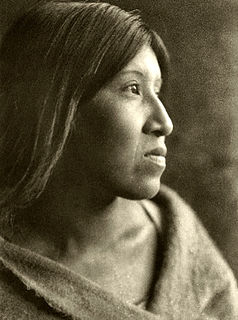External links
- The North American Indian by Edward S. Curtis (1926)
Traditional Narratives of Native Californians | |
|---|---|
|
|
Cahuilla traditional narratives include myths, legends, tales, and oral histories preserved by the Cahuilla people of the Colorado Desert and Peninsular Ranges of southern California.
Cahuilla oral literature has much in common with the traditions of the other Takic-speaking groups of southern California and with the Yumans of southern California, western Arizona, and northern Baja California. (See also Traditional narratives (Native California).)
legendary Indian stories
As told to Kate Collins.. LCC E99 C155 P3. OCLC 681440332 , 2298555

The Cahuilla, also known as ʔívil̃uqaletem or Ivilyuqaletem, are a Native American people of the various tribes of the Cahuilla Nation, living in the inland areas of southern California. Their original territory included an area of about 2,400 square miles (6,200 km2). The traditional Cahuilla territory was near the geographic center of Southern California. It was bounded to the north by the San Bernardino Mountains, to the south by Borrego Springs and the Chocolate Mountains, to the east by the Colorado Desert, and to the west by the San Jacinto Plain and the eastern slopes of the Palomar Mountains.
The Agua Caliente Band of Cahuilla Indians of the Agua Caliente Indian Reservation is a federally recognized tribe of the Cahuilla, located in Riverside County, California. They inhabited the Coachella Valley desert and surrounding mountains between 5000 BCE and 500 CE. With the establishment of the reservations, the Cahuilla were officially divided into 10 sovereign nations, including the Agua Caliente Band.
The traditional narratives of Native California are the folklore and mythology of the native people of California. For many historic nations of California, there is only a fragmentary record of their traditions. Spanish missions in California from the 18th century Christianized many of these traditions, and the remaining groups were mostly assimilated to US culture by the early 20th century. While there are sparse records from the 18th century, most material was collected during the 19th and the early 20th centuries.
Achomawi traditional narratives include myths, legends, tales, and oral histories preserved by the Achomawi people of the Pit River basin of Northeastern California.
Cupeño traditional narratives include myths, legends, tales, and oral histories preserved by the Cupeño people, of present-day inland San Diego County in Southern California.
Plains Miwok and Sierra Miwok traditional narratives include myths, legends, tales, and oral histories preserved by the Miwok people of the central California, specifically those of Sacramento Valley and Sierra Mountains. These Miwoks are the linguistically related speakers of the Plains and Sierra Miwok languages and their descendants. At the time of European entry, local groups that spoke these languages participated in the general cultural pattern of central California.
Eel River Athapaskan traditional narratives include myths, legends, tales, and oral histories.
Kumeyaay traditional narratives include myths, legends, tales, and oral histories preserved by the Kumeyaay people of southern California and northwestern Baja California.
Luiseño traditional narratives include myths, legends, tales, and oral histories preserved by the Luiseño people of southwestern California.
Maidu traditional narratives include myths, legends, tales, and oral histories preserved by the Maidu, Konkow, and Nisenan people of eastern Sacramento Valley and foothills in northeastern California.
Mohave traditional narratives include myths, legends, tales, and oral histories preserved by the Mohave people on the lower Colorado River in southeastern California, western Arizona, and southern Nevada.
Mono traditional narratives include myths, legends, tales, and oral histories preserved by the Mono people, including the Owens Valley Paiute east of the Sierra Nevada and the Monache on that range's western slope, in present-day eastern California.
Northern Paiute traditional narratives include myths, legends, tales, and oral histories preserved by the Northern Paiute people of the Great Basin deserts of western Nevada, eastern California, and southeastern Oregon in the United States of America.
Pomo traditional narratives include myths, legends, tales, and oral histories preserved by the Pomo people of the North Coast region of northwestern California.
Quechan traditional narratives include myths, legends, tales, and oral histories preserved by the Quechan (Yuma) people of the lower Colorado River area of southeastern California, southwestern Arizona, and northeastern Baja California.
Shasta traditional narratives include myths, legends, tales, and oral histories preserved by the Shasta people of northern California and southern Oregon.
Wintu-Nomlaki traditional narratives include myths, legends, tales, and oral histories preserved by the Wintu and Nomlaki people of the western Sacramento Valley in northern California.
Wiyot traditional narratives include myths, legends, tales, and oral histories preserved by the Wiyot people of the Humboldt Bay area of northwestern California.
Yokuts traditional narratives include myths, legends, tales, and oral histories preserved by the Yokuts people of the San Joaquin Valley and southern Sierra Nevada foothills of central California.
Yuki traditional narratives include myths, legends, tales, and oral histories preserved by the Yuki people of the upper Eel River area of northwestern California.